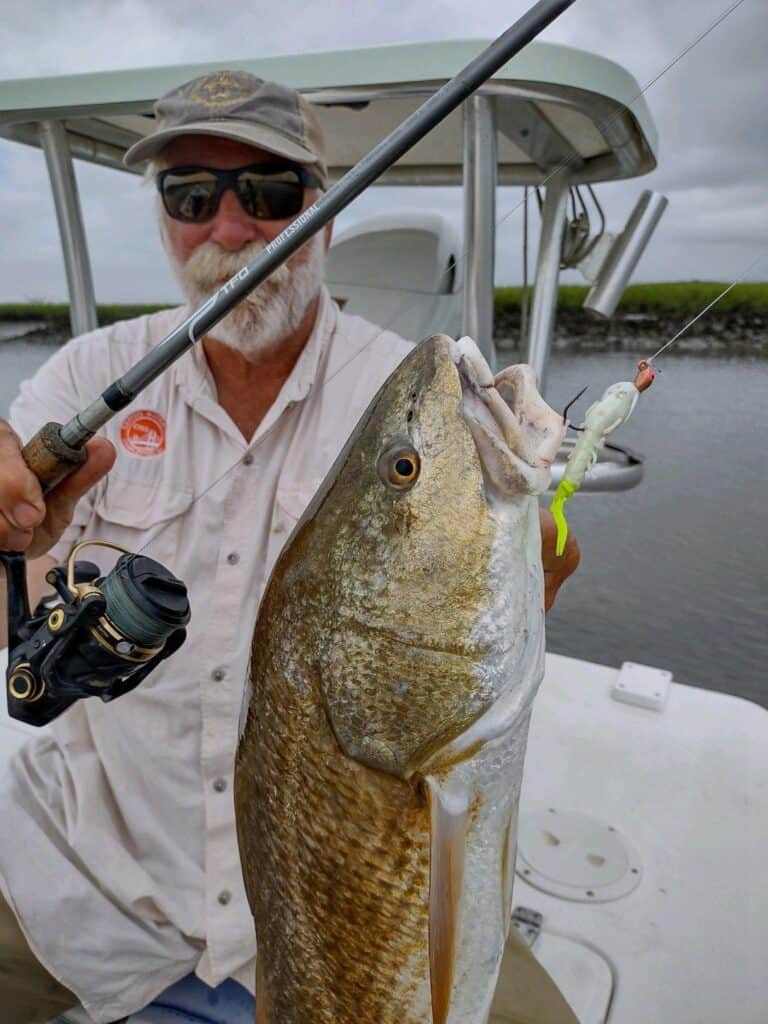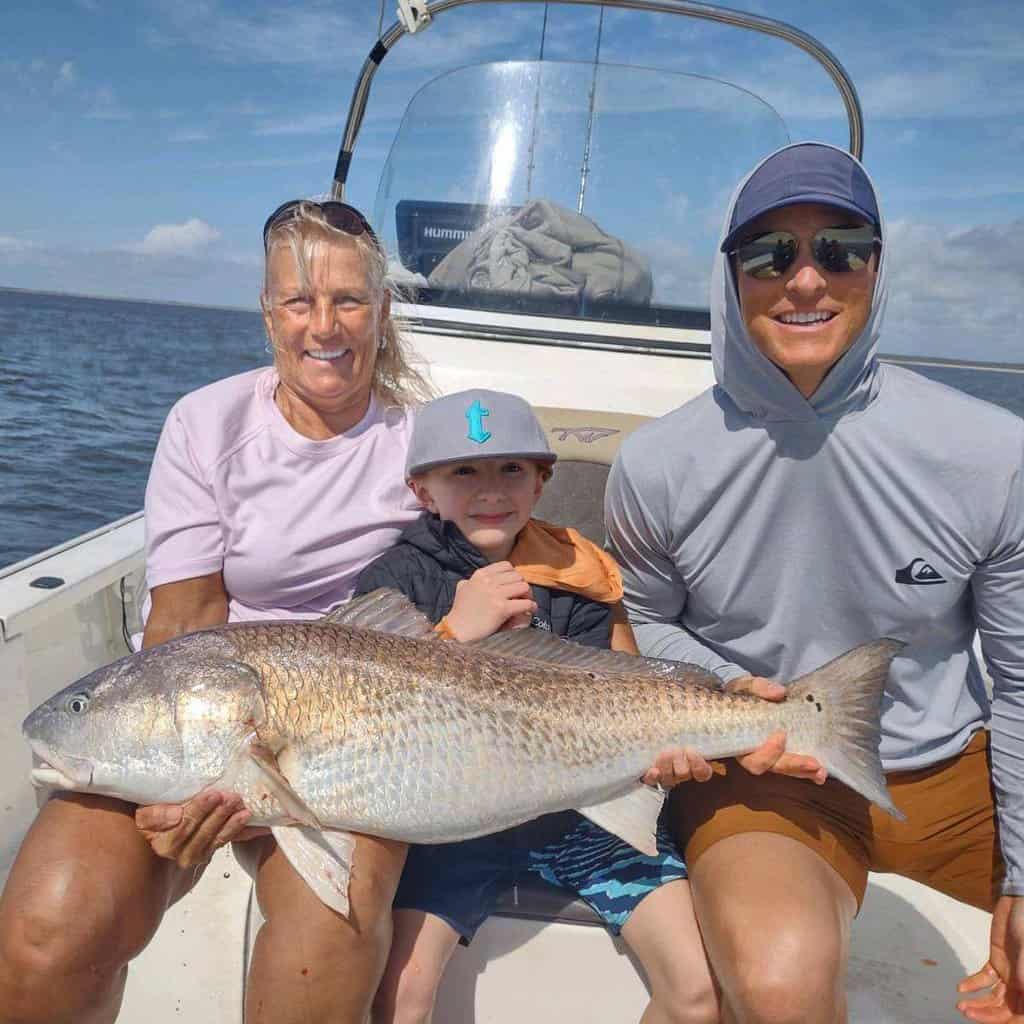South Carolina’s beautiful and rich coastline, full of marshes, rivers and flats, provides an ideal environment for great redfish action.
To bring you the best possible guide to South Carolina redfish fishing, I interviewed an old acquaintance, Tommy Scarborough of Georgetown Coastal Adventures, who has been targeting the fish officially known as red drum in South Carolina for more than 30 years.
There are few experiences like stalking big redfish in shallow water. Anglers love stalking these brilliant fish in shallow water, watching furious follows and topwater takes, and holding on as big reds plow across flats with reckless abandon.
Thankfully, Tommy agreed to share his knowledge to give you the skinny on finding and successfully targeting red drum in the best spots down the South Carolina coastline.
Where to Catch Redfish

To help keep you oriented, we’ll tackle South Carolina’s best redfish spots heading from north to south.
Locations we’ll cover early on will be nearby if you are fishing out of the Myrtle Beach area.
Heading south, you’ll find a generous handful of great redfish fishing spots in and around Charleston.
The last few redfish hot spots we’ll reveal are closer to Beaufort and Hilton Head for those fishing South Carolina’s southern coastline or heading north from Savannah.
Little River
About 30 minutes north of Myrtle Beach, on the North Carolina/South Carolina state line, the Little River is a rich environment for many species, including redfish.
The Little River connects to the Intercostal Waterway and Bird Island Reserve.
Where Little River empties into the Atlantic, there’s a jetty that can be a redfish magnet, especially on big tides. Game fish like redfish will use structure like jetties to pin schools of baitfish and gorge on them.
Target the pocket where the jetty forms a corner with the beach with small bucktails or a shrimp under a popping cork.
If you’re casting from a boat, keep a respectful distance from anglers fishing from the jetty.
Access: T. Craig Campbell Landing off Rte. 17 in the community of Little River will give boat anglers access via the Intercoastal Waterway.
Apache Fishing Pier
At just longer than 1,200 feet, the Apache Pier on the north end of Myrtle Beach is officially the longest designated wooden fishing pier on the East Coast.
That, and the fact that it features a seafood restaurant called Croakers and often live music right on site, might be reason enough to visit. But we’re here to talk redfish, and this pier can be a great place to target them without a boat and even if you’re traveling without your fishing gear.
The pier pilings provide the structure that attracts baitfish and the various sport fish routinely caught there, from sheepshead to sea trout to, of course, the beloved redfish.
There’s a bait and tackle shop on the pier for anything you need. You can rent a rod and even get the staff photographer to provide all the evidence you need to prove your monster catch.
Access: Apache Pier, 9700 Kings Road, Myrtle Beach.
Murrells Inlet
Another incredibly rich habitat on the South Carolina Coast is Murrells Inlet, about a half hour south of Myrtle Beach.
Here, the creeks and marshes stretch for miles and provide ideal habitat for much of the bait that allows some South Carolina redfish to get so big.
Scarborough says the water in Murrells is typically clearer than many redfish hot spots, allowing better visibility for the redfish and a chance for anglers to tempt fish even without making a perfect cast.
Murrells Inlet has jetties and docks that allow anglers to fish from shore. Additionally, a variety of underwater sand bars and drop-offs create ideal habitat for redfish to stage and ambush the variety of baitfish that come and go from the inlet.
A popular destination for several types of sport fish, Murrells Inlet is a South Carolina favorite and a place worth investigating for redfish anglers, for sure.
Access: There is a public launch off U.S. 17 (Business) in the community of Murrells Inlet that will put you into the inlet a couple of miles above the jetties.
Winyah Bay

Winyah Bay is Tommy Scarborough’s home water, and he hasn’t made that decision lightly. It’s a fishing paradise.
The bay, roughly halfway between Charleston and Myrtle Beach, has four significant rivers and many small creeks dumping into it, which bring life and nutrients into Winyah Bay. The Sampit River is a popular spot to intercept redfish, but many will hold these fish.
“If it’s high tide, I’ll start upriver and fall back as the tide drops,” Scarborough says, explaining that bait comes flushing out of rivers as the tide falls and the salinity levels in the rivers drop.
Redfish are voracious predators that feed on finger mullet, menhaden, croakers, spot, shrimp and crabs, among other things, and mimicking the predominant forage being washed out of these streams as the tide drops is crucial.
Access: East Bay Street in Georgetown features a public ramp.
Santee Coastal Reserve
Just south of Winyah Bay, the South Carolina Department of Natural Resources manages the Santee Coastal Reserve Wildlife Management Area, It also offers some outstanding fishing.
The Santee River splits into North and South branches before it reaches the Atlantic. Both branches empty in the Santee Coastal Reserve, which has barrier islands, marshes and public beach access.
These rivers bring the kinds of life and nutrients Scarborough explains are essential to healthy redfish populations. The strands of river form islands, like Cane Island, which give the reds structure that shelters them from the current.
The surrounding protected land offers anglers excellent access and opportunity. You can even request camping permits in person.
Access: The Pole Yard Public Boat Landing under the Rte. 17 bridge over the North Santee River provides boat access.
Additionally, Santee Gun Club Road will bring anglers to a boat dock and shore fishing areas on the South Santee River.
Sewee Bay/Bull Harbor
Sewee Bay and the larger connecting Bull Harbor is another great location for shallow-water, light-tackle redfish enthusiasts a short drive up the coast from Charleston.
The barrier islands inside the bay provide plenty of structure for redfish to ambush a variety of small baitfish that are pulled into the bay on the tide and trapped.
A flats skiff or kayak is the ideal means of targeting redfish in the shallow bay, as falling tides can leave little water.
Hickory Bay is a smaller connected bay between Sewee Bay and Bull Harbor. It has a series of tidal creeks flooding in that also has the potential to draw in redfish.
Access: Bulls Island Road will lead right to Garris Landing Public Boat ramp.
Sullivan’s Island/Breach Inlet
Sullivan’s Island sits at the northern edge of Charleston Harbor and is a redfish magnet close to South Carolina’s largest city.
The island’s north side, separated from the mainland by Inlet Creek, can offer incredible fishing.
Copahee Sound and Gray Bay are inland bays connecting to the Atlantic through a series of rivers and creeks, some flowing by Sullivan’s Island and through Breach Inlet.
Here again, we have the combination of structure in the way of islands and interconnected waterways, bringing bait back and forth from the rivers to the open ocean.
There are “grillages” off the coast of Sullivan’s Island. These structures are timbers that rocks are placed on to act as a breakwater. They were erected in the 1800s to prevent storms from eating away at the island and slowly submerging it.
Aside from preventing land loss, the timbers provide structure that regularly draws and holds redfish.
Access: There’s an unimproved launch at Station 26 and a private launch on Sullivan’s Island. Especially for larger craft, you might be better off launching over at Shem Creek Boat Landing on Simmons Street in Mt. Pleasant and motoring over.
Wando River
A number of rivers, including the Wando, the Cooper and the Ashley, flow into Charleston Harbor, bringing with them a variety of bait. All of these rivers hold redfish, but the Wando has a particularly promising selection.
When the rising tide brings life into the grass beds, redfish will push inland and corner finger mullet, shrimp, mullet or menhaden, depending on the season.
Kayakers will have fun in this shallow fishery, but keep an eye on the tides as the river is sometimes impassable at low tide.
Crabs are a plentiful food source for redfish on the Wando. Imitating them is a wise decision.
Access: Remley’s Point Public Boat Landing at 112 2nd Street in Mount Pleasant.
Cooper River
The Cooper River is another river that flows into Charleston Harbor and offers anglers shots at some big redfish in relatively shallow water.
One key here can be targeting the mouths of the smaller creeks that flow into the river. Small baitfish, crabs and crustaceans are swept out of these smaller creeks as the tide falls, and reds will sit at the creek mouths and wait.
It can be enormously effective to cast a small bucktail jig tipped with a shrimp tail into the creeks and work it in the current back to the main river. A gold spoon is another superb lure option for this tactic.
Access: Cooper River County Park, 1010 Tidewater Road, Charleston.
Folly Beach Pier
Just 25 minutes south of Charleston, another great fishing pier stretches more than 1,000 feet into the Atlantic.
The Folly Beach Pier features a large covered portion at the end on a large platform that provides plenty of space for many anglers. There are even fishing stations along the pier itself.
The pier periodically hosts fishing tournaments for children, who can win prizes.
The pier houses a gift shop, a tackle shop, restrooms, showers, and a bar and restaurant. The original pier was constructed in 1931, burnt down in 1977, and rebuilt in 1995.
Access: Folly Beach Pier is located at 101 East Arctic Avenue in Folly Beach.
Edisto
Farther down on South Carolina’s coast, Edisto Beach sits where the South Edisto River flows into the Atlantic Ocean.
A number of other small rivers and creeks, like the Ashepoo River and Rock Creek, all empty into one bay known as a particularly baitfish-rich section of the coast. That’s why the rivers and creeks can draw big redfish.
“With a lot of river access, the water gets and stays pretty muddy,” Scarborough said, and as he reminds us: “dirty water is nutrient-filled water.” Edisto is another example.
Access: Palmetto Boulevard in Edisto runs right past the beach.
Hunting Island State Park
With more than 5,000 acres of coastal grass beds and beaches, this state park near Beaufort and Hilton Head draws more South Carolina residents every year than any other.
Estimates show that more than a million outdoors lovers flock to Hunting Island State Park every year. A fair number of them are certainly anglers.
Right before Tarpon Boulevard/Sea Island Parkway crosses the Harbor River, a fishing pier on the northern end of the parkway is a great location for shore-based anglers, while boaters turn west to the Russ Point Boat Launch.
Depending on the tide, it’s also possible to wade into the river and sight-fish for redfish on foot, but as with any tide-influenced body of water, practice caution.
Kayakers looking for redfish in really skinny water can paddle inland from Russ Point and through Harbor River to target redfish there. Johnson Creek is another promising spot here.
Access: Russ Point Boat Launch is off Sea Island Parkway, west of the Hunting Island State Park Nature Center.
Catch More Redfish (Red Drum)
Be sure to read our simple fishing guide to catching more redfish.
Acknowledgment
Thank you to Capt. Tommy Scarborough of Georgetown Coastal Adventures for sharing his expertise for this article.

